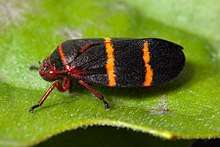Froghopper
| Froghopper | |
|---|---|
 | |
| Prosapia bicincta | |
| Scientific classification | |
| Kingdom: | Animalia |
| Phylum: | Arthropoda |
| Class: | Insecta |
| Order: | Hemiptera |
| Suborder: | Auchenorrhyncha |
| Infraorder: | Cicadomorpha |
| Superfamily: | Cercopoidea Leach, 1815 |
| Families | |
| |
The froghoppers, or the superfamily Cercopoidea, are a group of hemipteran insects in the suborder Auchenorrhyncha. Adults are capable of jumping many times their height and length, giving the group their common name, but they are best known for their plant-sucking nymphs which encase themselves in foam in springtime.
Taxonomy
Traditionally, most of this superfamily was considered a single family, the Cercopidae, but this family has been split into three families for many years now: the Aphrophoridae, Cercopidae, and Clastopteridae. More recently, the family Epipygidae has been removed from the Aphrophoridae.
Spittlebug nymphs
These families are best known for the nymphal stage, which produces a cover of foamed-up plant sap resembling saliva; the nymphs are therefore commonly known as spittlebugs and their foam as cuckoo spit, frog spit, or snake spit. The final family in the group, the Machaerotidae, are known as the tube spittlebugs because the nymphs live in calcareous tubes, rather than producing foam as in the other families.
The foam serves a number of purposes. It hides the nymph from the view of predators and parasites, and it insulates against heat and cold, thus providing thermal control and also moisture control; without the foam, the insect would quickly dry up. The nymphs pierce plants and suck sap causing very little damage, much of the filtered fluids go into the production of the foam, which has an acrid taste, deterring predators. A few species are serious agricultural pests.
%2C_East_Lyn_River%2C_Devon%2C_UK_-_Diliff.jpg) The spittlebug nymph
The spittlebug nymph- Nymphal form of spittlebug encased in foam for protection and moisture
Adults
Adult froghoppers jump from plant to plant; some species can jump up to 70 cm vertically: a more impressive performance relative to body weight than fleas. The froghopper can accelerate at 4,000 m/s2 over 2 mm as it jumps (experiencing over 400 gs of acceleration).[1] Spittlebugs[2] can jump 100 times their own length.
Many species of froghopper resemble leafhoppers, but can be distinguished by the possession of only a few stout spines on the hind tibiae, where leafhoppers have a series of small spines. Members of the family Machaerotidae greatly resemble treehoppers, due to a large thoracic spine, but the spine in machaerotids is an enlargement of the scutellum, where treehoppers have the pronotum enlarged. Members of the family Clastopteridae have their wings modified to form false heads at the tail end, an antipredator adaptation. Many adult Cercopidae can bleed reflexively from their tarsi, and the hemolymph appears to be distasteful; they are often aposematically colored (see photos).
References
- ↑ Burrows, Malcolm (December 1, 2006). "Jumping performance of froghopper insects". The Journal of Experimental Biology.
- ↑ Spittlebugs Lucy (April 29, 2017) Garden Ambition
External links
| Wikispecies has information related to Cercopoidea |
| Wikimedia Commons has media related to Cercopoidea. |